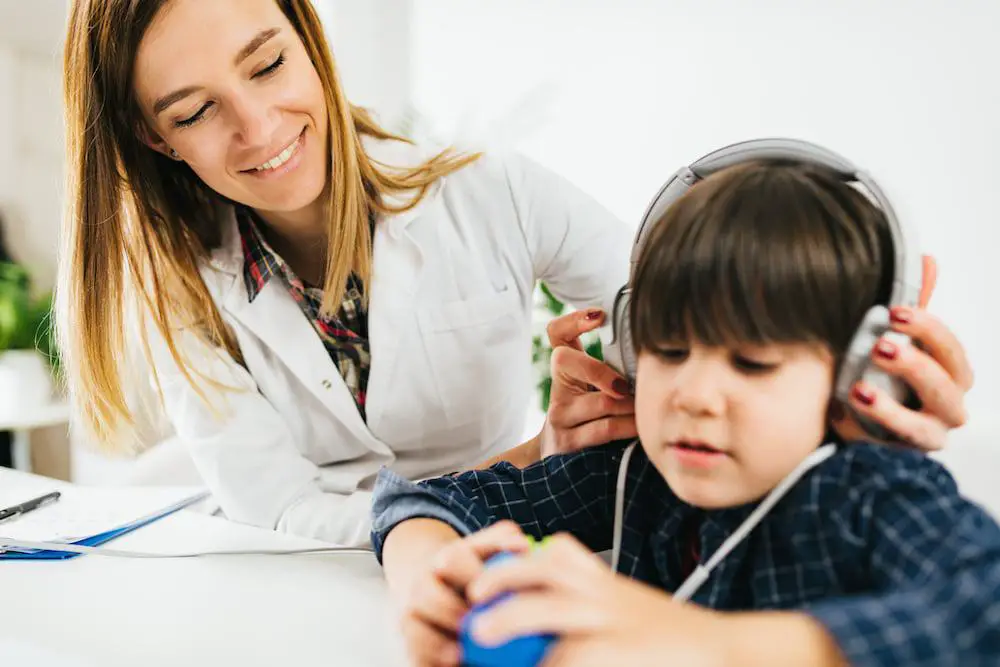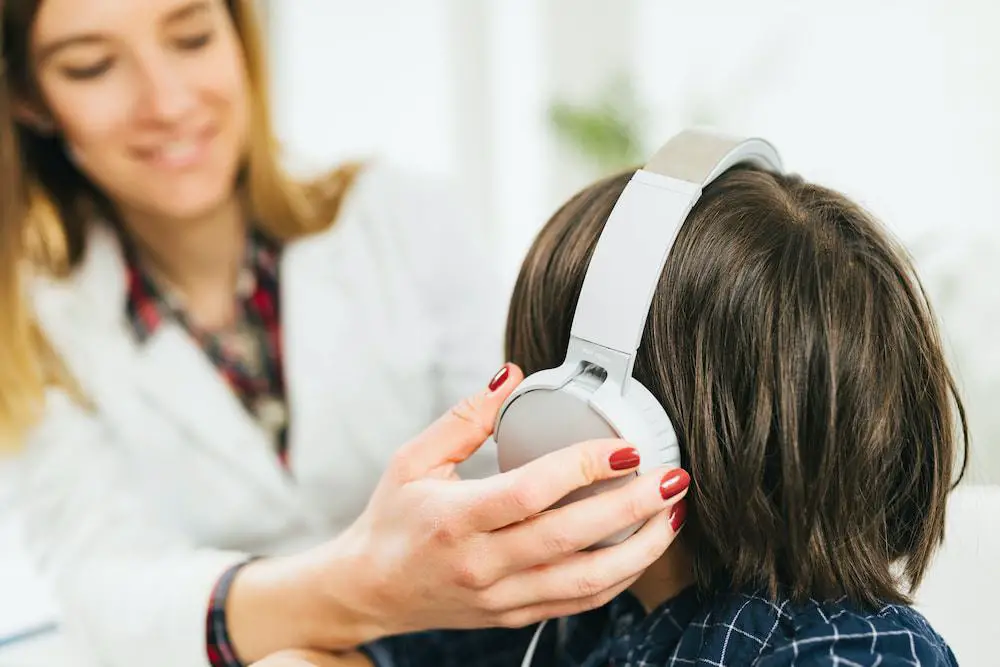Hearing loss is not the only thing that puts your child at risk of deafness; speech delays do, too.
Because of this, and to get one step closer to a diagnosis, acquiring a hearing test for kids is quite more common than you might think.
With the help of trained professionals, you can quickly have your child get a diagnosis to ensure they get the care they need.
Hearing Test for Kids
Hearing loss can affect us at any age, although it’s commonly discussed regarding our elderly years.
However, in truth, children can be just as affected by hearing loss symptoms and the challenges it presents.
When you opt to get a hearing test, there are several methods a professional audiologist will use.
Depending on your child’s health status, age, and development, specific tests might be recommended.
Often, he’ll go through behavioral tests, tone-based tests, and calibrated speech tests. All of which are used to determine how your child reacts to different types of audio stimuli.
The testing phase can be non-invasive and will be strange but comfortable for your child to go through.
How Do You Test a Child’s Hearing?
So, how do you test a child’s hearing capabilities? Here are a few types of tests a child gets to determine if there are problems with his hearing:
1. Auditory Brainstem Response Test (ABR Test)
With this procedure, the audiologist will be measuring how your child’s nervous system responds to sound.
They will insert earphones into your child’s ear canals and attach small sensors to the back of their ears and their forehead.
Through the earphones, clicking sounds will be sent, and the sensors measure how the nerves respond to sounds.
If your child is under six months, they can sleep during the test, although they will likely need sedation if older.
Toddlers and cooperative children can often do this testing in an environment with visual distractions.
As the results come in, they will be measured on a chart to determine if their brainstem works appropriately for speech.
2. Central Auditory Evoked Potential Test (CAEP Test)
A CAEP test is similar to an auditory brainstem response test in that it uses electrodes and earphones.
With this process, the audiologist can determine if the auditory cortex and brainstem are communicating correctly.
Often, this test is recommended for specific hearing loss types and can be done at any age.
3. Auditory Steady-State Response Test (ASSR Test)
For this procedure, it’s best if your child or infant is sleeping or sedated.
Sound will be brought through the ear canals, and a computer monitors the brain’s response to sound.
This process should help the audiologist know if the hearing loss is mild, moderate, severe, or profound.
For the results to be accurate, an ASSR test must be done in combination with an ABR test.
4. Otoacoustic Emissions Test (OAE Test)
As one of the more invasive tests, you’ll find most children won’t be uncomfortable with this process.
During an OAE test, an audiologist will insert a small probe into the ear canal, which sends out pulsing sounds.
The probe then measures and records the echo response from the hair cells in the inner ear. Regular readings can suggest the hair cells are working correctly.
Most healthcare practitioners use this method to screen newborns for hearing loss.
5. Middle Ear Muscle Reflex Test (MEMR Test)
This method is commonly referred to as an acoustic reflex test.
Its purpose is to determine how the ear responds to sounds by causing a reflex to occur. Healthy ears will instinctively reflex to protect the inner ear from loud sounds.
During this procedure, a rubber tip is put into the ear canal. Loud sounds are then sent into the ear, and the machine records if a reflex is triggered.
6. Tympanometry
As the last option, tympanometry is a specific procedure that focuses on the eardrum.
Audiologists will see how the eardrum moves when it’s exposed to air pressure and soft sounds.
It’s one of the best options for determining if there are any middle ear problems.
Types of Hearing Loss
As mentioned, a specific type of hearing test for children is recommended for different types of hearing loss.
There are five prevalent types your child might be experiencing.
1. Sensorineural
Sensorineural hearing loss happens when there is damage to the inner ear (cochlea) or if it’s structurally unsound.
This issue could involve certain areas of the cochlea, such as the outer or inner hair cells or both.
This problem will often begin at birth and results from a previous hearing problem or an inherited disorder.
Sensorineural hearing loss is most likely permanent and can be graded in four severities:
- Mild: Can’t hear certain sounds
- Moderate: Can’t hear many sounds
- Severe: Most sounds cannot be heard
- Profound: No sounds can be heard
It’s also likely this hearing loss will get worse over time, which will require repeated testing.
Children will need hearing aids to hear better, as surgeries and medicine cannot cure this hearing loss.
2. Conductive
With conductive hearing loss, the sound is unable to be transmitted to the inner ear. Ear infections are the most common cause of this, especially in young children and infants.
Most patients have mild and temporary conductive hearing loss, which can be repaired with surgery or medicine.
3. Central
Central hearing loss occurs when the cochlea works, but other parts of the brain fail. It’s a relatively rare type of hearing loss and can be challenging to treat.
4. Mixed
When a person is suffering from both sensorineural and conductive hearing loss, it is considered mixed.
5. Auditory Processing Disorder
APD is a medical condition that prevents the brain and ears from coordinating with each other.
Children with auditory processing disorder can hear well in quiet environments, but can barely hear in loud spaces.
Speech-language therapy is a fantastic way to assist children in dealing with APD.

When to Get a Hearing Test for Toddler
Fortunately, your child’s hearing is bound to be tested over their lifetime, especially when they’re younger.
At doctor’s appointments, they will do a basic hearing test for toddlers to determine any severe hearing loss indicators.
Also, they are tested as a newborn using initial hearing screening procedures.
If a newborn fails their initial test, they will require retesting within three months to begin treatment as early as possible.
Children will also be screened at regular intervals, typically between the ages of four and 10.
It’s also important to note that your family doctor can screen your children for hearing problems at any time.
If you have a significant concern or if your child exhibits the below symptoms, it’s recommended to seek professional help.
Signs of Hearing Loss in Child
There are several significant signs of hearing loss in child to consider, including:
Preferring Louder Volumes
If your child is prone to watching television or using delayed speech apps, the volume is something to pay attention to.
Children with hearing loss will often need to turn the TV up louder than usual to hear. Also, they will be likely to turn up the volume on auxiliary devices to hear better.
Exhibiting Learning Challenges
When your child begins school, their performance can reflect on their ability to learn.
Frequently, children with learning disabilities might have hearing concerns that affect their work and grades.
Just as adults, if you’re unable to hear the instructions, you won’t complete the project adequately.
Learning challenges can be due to many factors, including a history of speech delay in your family.
Failing to Respond
In conversations, your child must be engaged and listening, which should be easy to spot.
For example, if you call their name, a child with appropriate hearing will respond, unless they have another disability.
If you’ve begun to notice your child’s responses are few and far between, it could be a sign of hearing loss.
Showing Frustration in Loud Environments
It’s often that children with hearing loss get overwhelmed in exceptionally loud environments.
They will likely throw a fit or be visually disturbed by other conversations and sounds around them.
They won’t be able to converse and will often seem painfully distracted by loud noises. If this is the case for your child, it could be a sign of a hearing concern.
Signs of Hearing Loss in Toddlers
As with children, there are significant signs of hearing loss in toddlers to consider. A few of the most common signs to watch for include:
No Startle Reflex
Being afraid of loud noises is one of the fears we are innately born with. If something loud happens around your toddler, they are likely to jump, startle, or even cry.
Toddlers with hearing loss won’t have a jump or have a startle reflex if something loud occurs.
Inability to Recognize Voices
Even though your toddler won’t communicate, they can show their attention to your voice. Often, babies will coo or babble in response to their caregivers when they are spoken to.
If you find connecting with your child is challenging, it could be a sign of hearing loss.
Unable to Imitate Sounds
Another common symptom of hearing loss in younger individuals is their inability to imitate sounds.
As children grow, their speech revolves around mimicking sounds that they hear from their caregivers.
Toddlers with hearing loss won’t imitate sounds and use common words, like “Dada” or “Mama.”
What Causes a Child to Fail a Hearing Test?
There are several ways that a child can fail a hearing test, depending on the testing procedure used.
Typically, the test results will be charted or graphed alongside average results based on age and learning.
If your child’s scores are below average, this could result in further testing being required. For example, if a baby fails the Otoacoustic Emissions Test, they will need to be retested.
If they fail a second time, an audiologist will need to conduct a total hearing evaluation.
Parents need to understand the process of testing to determine what causes a child to fail a hearing test.
What Is a Normal Hearing Test Result for a Child?
Normal hearing for children is dependent on a variety of averages.
Using this chart, you can get an idea of what is a normal hearing test result for a child.
| Hearing Level (dB HL) | Hearing Loss Level |
| 10 | Normal |
| 20 | Slight |
| 30-40 | Mild |
| 40-50 | Moderate |
| 60-70 | Moderately-Severe |
| 70-90 | Severe |
| 90-120 | Profound |
Hearing Test for Children
Hearing tests are likely one of the most important things your child will experience.
Signing them up for a hearing test for kids can help to ensure they don’t encounter learning difficulties in the future.
With many different types of tests available, you can guarantee that your child will get the attention they need.

